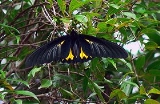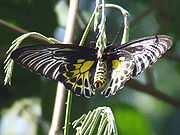
Troides minos
Encyclopedia
The Southern Birdwing is a large and striking Swallowtail
butterfly
endemic
to Peninsular India. With a wingspan of 140-190mm, it is the largest butterfly found in southern India.
It was earlier considered a subspecies of the Common Birdwing (Troides helena)
but is now recognised as a valid species.
The species is more common in the Western Ghats
, which is a biodiversity hotspot with a high degree of endemism in many taxa. It is much sought after by collectors and is a highlight of many butterfly-tours in the Western Ghats.

 Male and female. Differs from Troides helena cerberus as follows.
Male and female. Differs from Troides helena cerberus as follows.
It flies in a leisurely manner circling around jungle clearings and also frequents hill-tops. A determined flier, it is known to cover very large distances before settling.
The only food source is nectar, it also visits gardens and orchards and sips from domestic plants such as Mussaenda, Ixora and Lantana.
such as Aristolochia indica
, Aristolochia tagala
and Thottea siliquosa. The host plant toxins sequestered by the butterfly during its larval stage make it unpalatable to predators. Its flight and bright colouration advertise its unpalatability.
Swallowtail butterfly
Swallowtail butterflies are large, colorful butterflies that form the family Papilionidae. There are over 550 species, and though the majority are tropical, members of the family are found on all continents except Antarctica...
butterfly
Butterfly
A butterfly is a mainly day-flying insect of the order Lepidoptera, which includes the butterflies and moths. Like other holometabolous insects, the butterfly's life cycle consists of four parts: egg, larva, pupa and adult. Most species are diurnal. Butterflies have large, often brightly coloured...
endemic
Endemic (ecology)
Endemism is the ecological state of being unique to a defined geographic location, such as an island, nation or other defined zone, or habitat type; organisms that are indigenous to a place are not endemic to it if they are also found elsewhere. For example, all species of lemur are endemic to the...
to Peninsular India. With a wingspan of 140-190mm, it is the largest butterfly found in southern India.
It was earlier considered a subspecies of the Common Birdwing (Troides helena)
Troides helena
The Common Birdwing, Troides helena , is a beautiful and large butterfly belonging to the Swallowtail . It is often found in the wildlife trade due to its popularity with butterfly collectors...
but is now recognised as a valid species.
The species is more common in the Western Ghats
Western Ghats
The Western Ghats, Western Ghauts or the Sahyādri is a mountain range along the western side of India. It runs north to south along the western edge of the Deccan Plateau, and separates the plateau from a narrow coastal plain along the Arabian Sea. The Western Ghats block rainfall to the Deccan...
, which is a biodiversity hotspot with a high degree of endemism in many taxa. It is much sought after by collectors and is a highlight of many butterfly-tours in the Western Ghats.
Description
Description from Bingham, C. T (1907) The Fauna of British India, Including Ceylon and Burma. Butterflies. Volume 2.

- Male: Hindwing: the black along the dorsal and terminal margins both on upper and undersides much broader; on the upperside entirely filling interspace 1, on the underside with only a narrow streak of yellow at the angle between the median vein and vein 2; the cone-shaped black markings on the terminal margin shorter and broader; on the costal margin the black is narrower than in cerberus, barely extended below vein 8 excep at the base and apex of the wing where it broadens; the abdomen is dull yellow above and below not shaded with black.
- Female: Hind wing: the black on the costal margin as in cerberus, but there is always a large yellow spot at base of interspace 7; interspace 1 black, with a pale patch in the middle; the black terminal border broader, the inwardly extended cone-shaped markings prominent, those in interspaces 2 and 3 with pale buff lateral edgings, extended inwards to the postdiscal spots. In both male and female the hind wing on the upperside is clothed with soft, silky, long brownish-black hairs from base along the dorsal area.
- Expanse: 140–180 mm.
- Habitat: Southern India. Bombay to Travancore.
- Larva. Roughly cylindrical, tapers a little to each end, with two rows of fleshy processes somewhat curved forwards and a double row on each side that are much shorter. On the 2nd, 3rd and 4th segments an additional long pair between the dorsal and lateral rows. Head smooth and black; body of a uniform dark madder-brown, prettily lighted with a tinge of pink at the points of some of the fleshy processes; dorsal process on the 8th segment and a lateral pair on the 7th pinkish-white, with a band of the same colour uniting them.
- Pupa. Suspended by the tail and a band that encircles it much nearer the head than is usual with Papilio pupae. In form stout, flattened, dilated in the middle, with head and thorax thrown back. Head somewhat angular and tuberculated; two of the abdominal segments each with a prominent dorsal pair of pointed tubercles. Colour usually light brown, with a strongly contrasting saddle of old gold. (After Davidson & Aitken) - Mr T. A. Sealy (Proc. Ent Soc. 1875 p. 9) states- "The pupa possesses the power of making a curious noise like pha-pha!, and makes it very loudly when touched; the noise is accompanied (perhaps produced) by a short contraction of the abdominal segments. I thought at first it was merely produced by the rubbing of one ring of the pupa-case against the next, but the sound did not resemble a mere frictional sound, it was more like the sound of a rush of air through small holes. I tried to produce it with a dead chrysalis but failed: the pupa sometimes contracted on being touched without making the noise, and appeared unable to make the noise until some time was given to allow it to recover its vigour." Messrs. Davidson and Aitken have also noticed this power in the pupa, but they speak of it "as a husky squeaking noise, produced apparently by friction of the abdominal rings."
Status
The butterfly is locally very common in the southern and central Western Ghats. Also found in southern Maharashtra and northern Goa where it is uncommon. Despite its restricted range and endemicity, the butterfly is not known to be threatened but the IUCN recommends continuous monitoring.Habitat
Found up to 3000 feet in the Western Ghats. Found in diverse habitats from low-land evergreen forests near the coast to mixed deciduous forests, dry scrub and agricultural fields.Habits
Active during early morning hours when both sexes feed in the forest on Lantana and diverse foodplants. Later on, it is seen sailing as high as 30 to 40 feet over the countryside until it descends later in the evening to feed again.It flies in a leisurely manner circling around jungle clearings and also frequents hill-tops. A determined flier, it is known to cover very large distances before settling.
The only food source is nectar, it also visits gardens and orchards and sips from domestic plants such as Mussaenda, Ixora and Lantana.
Lifecycle
Though it flies all the year round, it is abundant in the during Monsoon and Post-Monsoon periods.Larva
Velvety maroon red with shiny black head and four rows of fleshy bright red tubercles. Grey markings on the back with a broad oblique pink white band on the 7th and 8th segments. These are heavily parasitised by tiny Braconid wasps.Pupa
Pale brown or green, marked with fine brown striations and minute markings. Found on the underside of leaves. If touched, it sways and makes hissing sounds.Foodplants
The larval host plants of these butterflies are small creepers and climbers of the family AristolochiaceaeAristolochiaceae
The Aristolochiaceae, or the Birthwort family, are a family of flowering plants with 7 genera and about 400 species belonging to the order Piperales...
such as Aristolochia indica
Aristolochia indica
Aristolochia indica is a creeper plant found in Kerala in India and also Sri Lanka. This plant is critical to the survival of the Southern Birdwing and Common Birdwing. It reaches a height of several metres on trees and cover the branches with thick foliage. It flowers once a year to produce seeds....
, Aristolochia tagala
Aristolochia tagala
Aristolochia tagala is commonly known as Indian birthwort and locally as Dutchman's pipe.-Distribution:It is widely distributed: the distribution is from the Himalaya to Sri Lanka through South East Asia and China, to Oceania...
and Thottea siliquosa. The host plant toxins sequestered by the butterfly during its larval stage make it unpalatable to predators. Its flight and bright colouration advertise its unpalatability.

